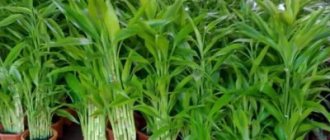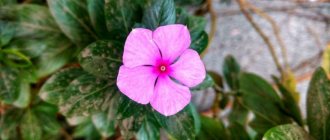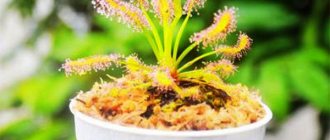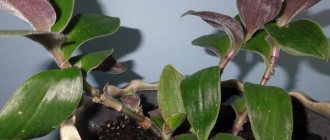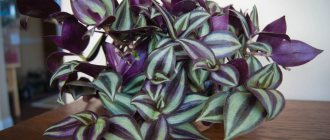Description and characteristics of the plant
Bamboo, which is used in the interior, belongs to the Dracaena family; only its appearance is similar to its wild counterpart.
Features of indoor bamboo:
- the stem is dense, fleshy with knotty isthmuses;
- green oblong leaves at the top;
- a healthy plant is bright green, the leaves are shiny, do not turn yellow or fall off, glossy and hard;
- does not bloom at home;
- grows both in soil and in water;
- feels good in conditions similar to natural ones.
The Chinese believe that bamboo brings happiness and good luck to the home.
How to water bamboo
Dracaena loves regular watering, but the process must be correct. It all depends on where it grows - in soil or water. If the plant is in a container, the roots should be covered with water. This level must be constantly maintained by adding liquid to the vase. Every couple of weeks the water needs to be changed to fresh and clean. Only distilled or melt water should be used because dracaena is very sensitive to salts and chemicals, especially in moderately moist soil.
Watering bamboo should be done every few days, along with spraying the foliage from a special spray can. Sometimes the soil in the container is dry to the touch, but this does not mean that you should increase the amount of liquid. It should be remembered that overwatering can harm the plant: the tips of the leaves will turn brown and it will begin to dry out.
- Treatment of seborrheic dermatitis at home
- Follicular cyst - causes and symptoms. Treatment of follicular cysts with medications and folk remedies
- Blue cheese - names, benefits and harm. Recipes for dishes with cheese with red, white and green mold with photos
Types and varieties of bamboo
- Ordinary bamboo. It blooms very rarely and is propagated by bush division. The stem is thick, rich green with bright yellow hues. In the wild it reaches 20 meters.
- Bloated bamboo. It grows up to 3 meters, is distinguished by thin branches and very lush foliage. Does not bloom at home.
- Multiple bamboo. It has the appearance of a shrub consisting of a large number of individual trunks, grows up to 40 m, the stems are thick and flexible, the leaves are hard, glossy, deep green.
- Indoor bamboo. A miniature plant, it produces hard and glossy leaves of a light green hue only at the top, the trunk is smooth and bare.
- Bamboo varnishes. A perennial subshrub with leafy shoots at the top and smooth trunks. The plant is rich green in color.
- Longispiculata bamboo. Grows up to 15 meters. The trunk is bare, gnarled, the leaves at the top are sharp and hard.
- Tulda. This bamboo is used to make paper. The plant is bright green in color, but then acquires a grayish tint, a trunk with thin branches and green foliage.
- Blumeana. It can grow as a shrub or with single stems. The trunk is thin, with a gray tint, covered with branches with thorns and dark green foliage.
Description of the plant
In the 19th century, the plant was brought to Europe from China by the English botanist Frederick Sander. The plant has a hollow, bare, segmented stem, at the top of which shoots and glossy lanceolate leaves grow. The color of the stem and leaves is most often bright green, but there are varieties of golden and dark green shades. The stem grows quickly; even dwarf varieties can grow up to 1 meter in height in a few months.
Indoor bamboo is used for decorative purposes to decorate the interior of apartments and offices. The stems of Dracaena Sander can be easily shaped into any shape, which is why the plant is most often used in various compositions. In addition, not only soil, but also an aquatic environment is suitable for growing dragon tree, so the plant is often used to decorate aquariums.
In fact, indoor bamboo is a flowering plant. Once in its life, the dragon tree may produce a flower-bearing arrow with small white flowers. Flowering takes a lot of energy from the dracaena, so after it the plant dies. The few witnesses to this phenomenon note the pleasant aroma of the flowers.
Requirements for growing bamboo at home
Bamboo is called a lucky plant. Growing it at home is a real pleasure; it is unpretentious and can live in a vase with water or in a pot with soil. The stems can be twisted into a spiral and made into compositions for room decoration. But in order for the plant to be healthy, there are some care features.
Lighting and location
Bamboo's natural habitat is the tropical forest, where the sun's rays are scattered. Therefore, it is better to place the plant on windowsills on the eastern side and it is advisable to have a light curtain on the window; the bright sun burns the leaves and they can turn yellow. But bamboo can also suffer from a lack of light, so if you want to place it in a dark corner or in the bathroom, provide additional lighting, for example, using fluorescent lamps.
Temperature
Indoor bamboo is heat-loving, tolerates heat up to +30 °C without any consequences, but the comfortable mode is from 18 to 25 degrees plus. The plant loves fresh, clean air, so ventilation will benefit it.
Air humidity
And here bamboo is not whimsical, but it is better to avoid dry air and not place the plant near heating devices. The leaves need to be wiped off dust more often and given a warm shower.
Rules of care
Growing bamboo at home will not cause problems if you know a few nuances. The website flowery-blog.ru has collected the main and most important points.
Water or soil? This is the first question that worries new owners of dracaena bamboo. The remaining stems from the bouquet usually stand in the water while you think about whether it’s worth planting them in the ground, or whether you can continue to grow them in a vase? Either way is correct! But each has its own characteristics. So, if you leave your dracaena in water, be sure to change the water regularly so that it does not “bloom.” It is not recommended to fill the vase with cold water; it is best to use warm and settled water for watering other plants. It is also a good idea to periodically add soluble fertilizer (in this case, liquid fertilizer is better) to a vase of water to compensate for the deficiency of nutrients. Indoor bamboo at home will also feel great in the right soil. Read below how to plant it.
Temperature and lighting
Homemade bamboo is not picky about temperature conditions - it adapts well to cool air of + 15 degrees and feels great on hot days even at 35 degrees. In the summer, you can safely take it out to the balcony to “breathe.” Just shade the plant from the sun's rays! The hot sun can burn tender leaves.
This type of dracaena develops well in diffused light and partial shade. Excess sun can quickly harm it! Therefore, growing an ornamental bush on a south-facing windowsill is not the best idea. Place it some distance from the window, and in winter, use artificial lighting to make up for the lack of light. Which backlight lamps to choose.
Watering and humidity
The need to regularly change the water in the vase is written above (if you keep your flower in water). If your ward grows in the ground, it, like any plant, needs watering! This should be done regularly approximately once every 7 days, depending on the temperature. Don’t let the soil dry out too much, but a swamp is not the best environment for dracaena growth! Despite the fact that it survives well in water, excess moisture in the soil can negatively affect the plant.
Ways to grow indoor bamboo
Growing bamboo in a container with soil
Bamboo feels better in soil than in water. It develops a good root system and you can grow a beautiful plant, the size of which will depend on the development of the roots. The smaller the pot, the shorter the stems will be.
Instructions for growing in soil:
- choose a pot, preferably squat with a large diameter;
- It is better to purchase special soil for growing dracaenas, but you can also mix peat, humus and clay turf yourself;
- ensure good soil drainage;
- once a month the plant needs to be fed;
- the soil should be constantly slightly moist, but not too wet;
- Replantation is recommended every three years.
Growing bamboo in water
Bamboo feels good in water and produces abundant leaves, but this method requires discipline - the water must be changed at least once a week.
Instructions for growing in water:
- prepare the root system, remove damaged roots;
- select a high container, something like a flask;
- filtered water can be used, but settled water will not cause harm;
- Carefully place the plant in a container and cover the roots with decorative stones;
- the water should always be clean, do not let it stagnate and bloom;
- Once a month you need to fertilize the plant.
Growing bamboo in hydrogel
The process is identical to that of growing in water with decorative stones, but somewhat simpler. Instead of stones, the roots are covered with granules and filled with clean water, then all that is necessary is to add water as needed and feed once every six months. It is better to choose a hydrogel with small granules, they will not allow the root system to be exposed.
Advice! In a container with bamboo, you need to maintain a low water level, just so that the roots are covered; if the trunk is in the water, then roots will appear at this distance, which does not look aesthetically pleasing.
Trimming and propagating bamboo in water
If the bamboo has grown too much and no longer looks attractive, then pruning should be done. It is done with special scissors, above the knots, otherwise the cut will be ugly.
Pruning can be done annually, trimming long shoots on all sides, and if necessary, removing outer canes at ground level.
By removing side shoots from the desired sides, you can model the shape and appearance of bamboo as you wish. Pruning can also be used to propagate bamboo. In this case, either cut off the top cuttings and root them in water, or cut the stem into several parts, lubricating the cuts with soft, but not hot, wax. Under no circumstances should yellowed areas of bamboo be used for propagation. If there are no shoots, then you can cut the top and after such an operation a shoot should grow, but if it does not appear, then repeat pinching the stem.
Indoor bamboo: care at home
Watering
Indoor bamboo is very moisture-loving and requires regular watering. The difficulty is that oversaturation with moisture must be avoided.
- If the plant is in water, make sure that it completely covers the roots. The water needs to be completely changed every week.
- Bamboo in the ground must be watered once every three days and the soil should not be allowed to dry out; the plant needs to be sprayed at the same frequency. If you are away from home for a long time, provide automatic watering.
Feeding and fertilizers
The plant needs to be fed during the active growth phase. The frequency of feeding is once every 20 days. In winter - once every two months.
It is better to take fertilizers for bamboo specialized for dracaenas; it must contain nitrogen and phosphorus.
Advice! It is better not to fertilize dracaenas purchased in the store before 6 months. In stores and nurseries, all flowers receive a huge amount of fertilizer.
Transplantation, water change and substrates
Until the age of 4 years, the plant is replanted every year, like other flowers; replanting is recommended in the spring. Adult bamboo needs to be replanted no more than once every 3 years. After transplantation, the plant will acclimatize for about 2 months, then it will begin to develop as usual.
If bamboo grows in water, then “transplantation” is carried out as soon as signs of sediment appear. In this case, there is no need to change the vase; you need to carefully remove the plant, pour in clean filtered water and return the plant back.
When planted in water, the plant does not need a substrate, but to secure the thin roots, it is better to add pebbles or decorative stone to the water. The substrate needs to be washed with each transplant (the hydrogel is not washed, it is changed at intervals recommended by the manufacturer).
Bamboo blossom
Flowering for bamboo is an extremely rare process; it is believed that indoor bamboo does not bloom at all. But if you are lucky and your pet blooms, most likely it will die after that. The plant spends all its energy and nutrients on flowering. If you want to preserve the bamboo, then the flower arrow needs to be cut off and the cut area treated with charcoal.
Trimming
Bamboo is very tolerant of pruning and tolerates it well. Designers adore him for this - he can create various interior compositions.
Trimming rules:
- You need to prune when the plant is completely healthy and rooted;
- First, excess stems and dry leaves are cut off;
- to prevent the stem from growing upward, pruning is done above the branching point;
- lastly, remove excess shoots.
How to twist a bamboo trunk
The plant is quite elastic, which allows bamboo to be molded into various shapes. But the process is slow and requires patience.
Step-by-step instructions for twisting:
- Place a guide in the pot with the plant, around which the stem will curl. The sprout must be securely attached to the guide. You can remove the structure when the stem becomes rigid.
- Cover the bamboo with something opaque and leave a hole for sunlight to enter - that’s where the bamboo will tend to grow. For example, you can take a box, place a plant there and remove only one wall, the stem will begin to turn towards the sun.
- To twist the stems together, the sprouts are carefully twisted and secured with wire. After the stems have strengthened and become strong, remove the wire; the trunk will remain in this position.
How to transplant bamboo from water to soil
Dracaena can grow in water or vases with hydrogel, but it behaves best in soil. Planting lucky bamboo in a suitable container and new soil will improve the health and prolong the life of the plant. How to plant bamboo in a pot:
- You need to choose a container whose diameter is several cm larger than the base of the bamboo stems. Replanting in a deep, wide pot works best. The container must have at least one drainage hole.
- Fill the container with moistened soil to 1-2 cm. There should be no fertilizers in the soil.
- How to transplant bamboo from water to land? You should:
- Grab the stems at the base and pull them out. Gently shake the roots if necessary.
- Place the dracaena in the prepared pot.
- Add more soil, filling most of the container.
- You can water the plant until moisture begins to flow out from the bottom of the pot. Once this happens, the drain pan should be emptied.
Pruning Dracaena Sandera
The plant can reach enormous sizes. If the lucky bamboo is too tall for the room, it is worth trimming the stems by removing 1/4 of the length. It is better to plant the cuttings in a pot to grow young dracaena. The plant is very tolerant of pruning, so its height can be easily adjusted. How to trim bamboo:
- It is necessary to remove dried or small shoots at soil level.
- To prevent the stem from growing, you should trim it above the branching point.
- Regular removal of thin branches promotes vertical growth.
- You can trim the lower branches for aesthetics.
How to propagate happiness bamboo
Cuttings
Propagation by cuttings is carried out in the spring. Separate the young branches from the adult plant and transplant them into the ground. The soil mixture is standard for dracaenas. Roots will appear in about a month. Cuttings can be combined with annual replanting of bamboo.
Seeds
The most difficult and time-consuming method, and indoor varieties are almost impossible to grow from seeds.
How to germinate bamboo seeds:
- build a mini-greenhouse on the windowsill;
- soak the seeds in warm water;
- plant the seeds in peat tablets and sprinkle with soil mixture;
- ventilate the greenhouse 2-3 times a day;
- moisten the substrate regularly;
- sprouts will appear in approximately 10–20 days.
Plant the germinated seeds in open ground and wait for shoots to appear, which you can then replant in the standard way.
Dividing the roots
This method of reproduction is extremely rare. When an adult plant is transplanted, at this moment large shoots are separated and immediately planted in the soil in a separate container. Until the shoot takes root, it needs to be watered abundantly.
What you didn't know about indoor bamboo
There have been changes in the names of bamboo varieties recently, which leads to some confusion among those gardeners who know their previous names. A comparative list of these changes would be useful.
| New name: | Old name: |
| Bashania fargesii | Arundinaria fargesii |
| Pseudosasa japonica | A. japonica |
| Fargesia murienaliae | A. murienaliae |
| F. nitida | A.nitida |
| F. palmata | A. palmata |
| Pleoblastus pygmaeus | A. pygmaea |
| P. variegatus | A. variegata |
| P. auricomus | A. viridistriata |
| Indocalamus tessellatus | Sasa tessellata |
Bamboo growing in containers can be transplanted into open ground at any season, not coinciding with frosts and droughts, in places protected from direct cold winds; be sure to mulch the root zone to preserve moisture.
A clump of bamboo planted in a spacious and large pot looks picturesque on a balcony or in a patio with normal, regular watering, for which the short and cold-resistant species Shibatea kumasasa is most suitable.
If you want to grow taller bamboo (Fargesia murienaliae or F. nitida) in a pot, you will need not only a large pot, but also one that is heavy enough so that it will not be knocked over by the wind, but this is due to the need to replant the bamboos into a larger pot each year, since they are quite grow quickly.
Bamboo growing in a pot on the balcony can be left there in winter, covering its soil layer with a thick layer of straw and wrapping the entire curtain with the pot in several layers of polyethylene, loosely tying it with a rope to the very top.
Answers on questions
Is it possible to keep bamboo in an apartment?
Indoor bamboo is specially bred for growing at home. According to Feng Shui philosophy, bamboo attracts good luck and happiness to the house, and grants longevity to the owner. That's why it is called lucky bamboo.
Why does bamboo turn yellow?
The evergreen plant may turn yellow. This may happen due to:
- lack of light;
- exposure to direct sunlight;
- lack of moisture;
- lack of nutrients;
- poor drainage system;
- drafts;
- watering with unfiltered water.
How fast does indoor bamboo grow and what to do if it grows very slowly
The growth rate is incredible; on average, bamboo reaches medium size in 5 years. If the dracaena suddenly stops growing, this indicates watering with hard water and lack of light.
Leaf blades become limp and curled
This is due to hypothermia.
Why do black spots appear on bamboo leaves?
Bamboo is affected by fungus; ventilation must be provided.
Is it possible to prune indoor bamboo?
It is possible and necessary to trim homemade bamboo; this is often done for decorative purposes.
How to root bamboo at home
For rooting, pinch off the top and place in a glass of water until roots appear. When the first shoots appear, the bamboo is planted in a pot with soil.
Feeding bamboo
Dracaena does not require a large amount of fertilizer and can be kept in clean water for a long time. For the first 2 weeks, it is better not to feed the plant at all, because excess nutrients will harm the plant. How to fertilize bamboo at home? To feed Dracaena Sandera, you can use regular water from the aquarium (if the plant is in a vase) or a water-soluble fertilizer for indoor plants with a high nitrogen (N) content. It should be fed every month, starting with the arrival of spring.
Diseases and pests
Lucky bamboo has good immunity to disease, but problems can occur during cultivation, and you need to be prepared for this. In the table we have indicated the answers to the most frequently asked questions.
| Problem | Cause | Solution |
| Dark spots on leaves. | Fungal rot. | Cut off problem areas, treat the cut areas with wax, and treat the plant with a fungicide. |
| Darkening and falling leaves. | Hypothermia. | Maintaining a comfortable room temperature. |
| Sticky leaves. | Aphid. | Treat with insecticide. |
| Cobwebs on leaves. | Spider mite. | Treat with insecticide or soap solution. |
| Slow growth, yellowing of stems and leaves. | Lack or excess of fertilizers. | Do not neglect the instructions when introducing fertilizing. Follow the recommendations from the “Feeding” section. |
| Falling leaves. |
|
|
Let’s take a closer look at the question of why indoor bamboo turns yellow. There can be quite a few reasons for this, and it will take time to determine the correct one. Here is their list:
- drafts;
- dry air;
- prolonged exposure to direct sunlight;
- poor quality of water used for irrigation;
- moisture deficiency;
- light deficiency;
- thin layer of drainage.
If you immediately see the problem, then correcting the shortcomings will not be difficult. If not, all you have to do is normalize the care of bamboo, fully following all the rules specified in this article.
Twisting into a spiral
Often, you can find specimens of indoor bamboo for sale with original and bizarre shapes. This is facilitated by the distinctive ability of the stem to bend and remember its shape. We'll tell you how to achieve this shape at home.
Method 1. Place a stick, cylinder or any other support of the required shape in a flower pot and wrap the stem around it. At first, the structure must be secured with wire. Once the stem becomes woody, the wire and stick can be removed.
Method 2. Cover the pot with the plant with a box so that one side flap is open. The remaining doors and the top must be closed. Then the light will enter the box only from one side - this is where our bamboo will stretch as it grows. After a while, when you can see the stem tilting to one side, turn the box so that the sun hits the dracaena from the other side. So, by constantly turning the box, you can curl the stem of your specimen into a spiral. But this method is very long - one turn can take up to a year.
This may be interesting: Syngonium - home care
You can create other, more complex compositions from indoor bamboo, but we’ll talk about this some other time.
